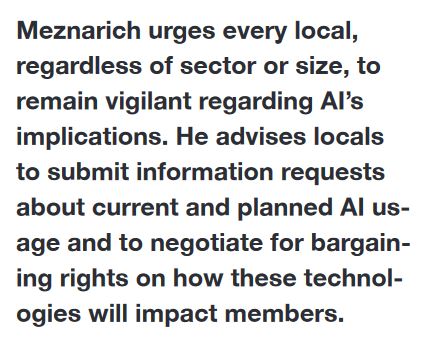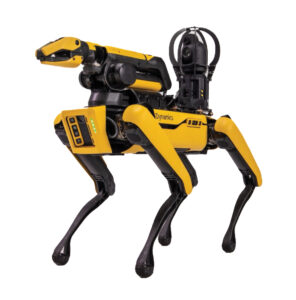Chatbots, virtual reality training, and robotic ‘dogs’ patrolling substations — these are just a few examples of the artificial intelligence (AI) technologies that UWUA members are encountering in their workplaces. Whether we’re ready or not, AI is rapidly transforming our jobs, our workplaces, and the skills needed to succeed. The adoption of AI is accelerating across various sectors, broadening its applications at an unprecedented pace.
AI offers significant potential to simplify tasks, boost productivity, and create new employment opportunities. For instance, AI can detect and flag issues that human observation might miss, enhancing safety and efficiency. However, these advancements also bring substantial challenges. AI has the potential to diminish job quality and, in some cases, eliminate jobs entirely. The use of AI also raises critical ethical concerns, including privacy, data security, and fairness. AI systems depend on vast amounts of data, and if that data carries inherent biases or mirrors societal inequalities, it can perpetuate discriminatory outcomes.

UWUA Senior National Representative Frank Meznarich recently attended an AI webinar and expressed significant concerns about the rush by companies to embrace AI before all its issues are resolved. “What struck me was AI’s ability to manipulate data to promote a particular outcome,” he said. For instance, if Employee A is the top candidate for a promotion, the data could be manipulated to favor Employee B, moving them to the top of the list.
These issues underscore the importance of staying informed about how these technologies are being implemented and their potential for broader applications. For all these reasons, it is essential for members to be proactive in understanding AI’s implications and ensure that its integration into the workplace aligns with the best interests of workers.
Some locals are already taking proactive steps, submitting information requests to employers and negotiating for contract language to protect members as AI and other emerging technologies are introduced. The key is to address the issue head-on and ensure that AI’s integration into the workplace is guided by union input, safeguarding members’ interests.
One of the most widespread applications of AI is in customer service. Rich Nasca, a business agent with Local 1-2, reports that companies across the country have long employed chatbots in customer service, to the extent that customers often only interact with a live person after leaving a message and receiving a call back.
Other locals are experiencing similar shifts. Local 640, representing members in customer service at American Water across several states, reports that the company is introducing a new phone system featuring automated chatbots which customers must navigate before speaking with a representative. “They say there’s enough work to avoid job losses, but we’re concerned that it will reduce call volume,” said Jay Ellifritz, the local’s treasurer.
American Water has also launched a new web portal for non-residential customers, such as sewage authorities, providing direct access to information that was previously obtained through a phone call with a live agent. Additionally, a portal launched on September 1st for Pennsylvania customers now requires inquiries about new services, such as meter fixes or tap orders, to be submitted online, with information automatically routed to local operations for field implementation. The company plans to expand this system to other states. “Again, American Water assures us that our members will still handle other types of calls, but it’s clear our call volume will be reduced,” Ellifritz said. Local officers are assessing the long-term impact.
Ellifritz is also concerned about field jobs. “New smart meters do more than just provide usage data; they can turn water services on or off without human intervention,” she noted, adding that American Water is already installing this technology in West Virginia and Tennessee.
Of particular concern to Local 640 is AI’s role in monitoring work. Nearly all members work from home, and within the past year, the company has installed a virtual desktop interface (VDI) system that allows AI or a live supervisor to monitor every keystroke, the duration of each interaction, and even voice tone and background noise. Any flagged issues are automatically brought to a supervisor’s attention.
As the local approaches its next contract bargaining, Ellifritz emphasized that they will propose a union voice in how new technologies are introduced and utilized.
Gas workers at Local 132 already have contract language that addresses the introduction of new technologies affecting their work, requiring SoCal Gas to bargain with the union. Javier Salas, the local’s regional officer for call centers, stated that they are seeking to strengthen this language in their current contract negotiations. “We’re dealing with everything from chatbots in call centers to Los Angeles’ new hydrogen hub. We aim to ensure our members are prepared and protected, whatever the future holds.”
Salas noted that AI’s impact on customer service began years ago when the company closed several walk-in payment centers. The most recent push aims to close the few remaining centers, forcing customers to use the company’s automated online system and putting live agents’ jobs at risk. “For the past three years, customer service reps have been required to update customers’ phone numbers and e-mails with every call, enabling SoCal Gas to send a link for online bill payments,” Salas said.
SoCal Gas is also implementing what they call a ‘Conversational IVR’ (Intelligent Voice Response) system for its call centers. Customers will interact with AI, bypassing live representatives until later in the process, or potentially all together. The company claims this will improve response times and availability.
With 60% of call center members now working from home, Salas raised concerns about visibility: “Members are no longer in the same place at the same time, so we have to be more diligent in tracking how AI and other technologies are impacting not only work but attrition.”
Salas emphasized AI’s use isn’t limited to call centers. SoCal Gas introduced automated meter reading years ago and is now exploring the implementation of AI-driven smart meters. In addition, while the company still relies on leak survey members to physically inspect streets, they are increasingly utilizing drones to detect methane leaks. Additionally, the company has developed a new system to automate the dispatch function. When a customer places an order, the system automatically routes the work order to a field technician based on their location and availability, which could eventually eliminate the need for a dispatcher. Local 132 currently represents approximately 100 dispatchers working in both distribution and customer service.
Across the country in New York, Local 1-2 is witnessing the use of AI beyond customer service. Rich Nasca reports that new technologies like robotics and AI are being developed and implemented at a rapid pace. “Everyone should be aware. I often get calls from members saying, ‘You’ve got to see this really cool new thing.’” He cautioned that members are often too impressed by these innovations without considering the long-term implications for their jobs.

For example, ConEd has introduced a robotic ‘dog’ at substations to read gauges and detect gas leaks and hot spots—tasks currently performed by union members. The company also invested in the development of a machine for splicing underground cable, where a live splicer would set up the machine and then operate it remotely from above ground. Local 1-2 President Jim Shillitto shared, “It’s not yet been approved for field use, but we’re watching this closely.” For now, it appears this technology won’t eliminate jobs since it still requires a skilled splicer, but over time it could lead to deskilling and diminishment of union employees in these positions. He advises union officers across the country to be diligent in ensuring these evolving technologies are operated and managed by union workers.
ConEd has also introduced virtual reality (VR) training, where trainees wear VR goggles and use virtual tools, receiving step-by-step instructions on how to perform tasks. While this method makes skill transfer easier, it raises concerns about how quickly management could replace union members in event of a work stoppage or strike.
Shillitto noted the company often presents these new technologies as ‘safety’ improvements to gain union and worker buy-in: “This is the hook to get us on board, and it’s effective because we all want to avoid hazards. They sell it as safety, but it could ultimately eliminate jobs, so we monitor closely.”
The local’s new contract, ratified in August, includes an Emerging Technologies Committee. “This committee will discuss and evaluate the impact of emerging technologies on bargaining unit employees, including the skills and training relevant to evolving work practices,” Shillitto said.
Meznarich urges every local, regardless of sector or size, to remain vigilant regarding AI’s implications. He advises locals to submit information requests about current and planned AI usage and to negotiate for bargaining rights on how these technologies will impact members. “Read the writing on the wall. It’s happening, so do your best to prepare and protect your members.”
Phoot caption: The robotic ‘dog’ ConEd is introducing in some of its substations.

